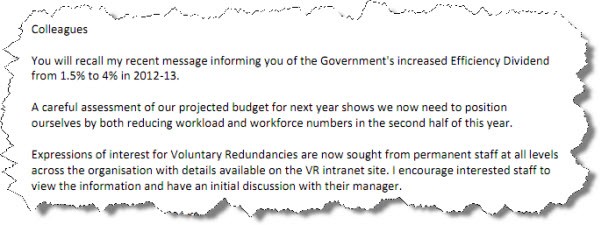The massive Commonwealth Department of Health has been forced to call for voluntary redundancies and will cut its workload in response to the government’s additional 2.5% efficiency dividend announced in MYEFO a fortnight ago.
As the department dispatches its new minister briefing package to the incoming Tanya Plibersek and adjusts to having two cabinet ministers in the portfolio, controversial secretary Jane Halton issued an email to staff this morning calling for volunteers to take redundancies.
“A careful assessment of our projected budget for next year shows we now need to position ourselves by both reducing workload and workforce numbers in the second half of this year,” Halton said. She wants expressions of interest in what are called “VRs” in the bureaucracy by late January, with staff to be out the door by March. Halton insisted there would be no involuntary redundancies:
“This is a completely voluntary process. Guiding Principles and other information can be found on the VR intranet site to ensure a transparent, and consistent process. There is no guarantee that employees who nominate will be offered a VR as we must retain a highly capable workforce with the capacity to deliver the Government’s ongoing health and ageing agenda.”
This is an acknowledgement of the often-ludicrous process of mass redundancues in 1996-97 when the Howard government came to power and eliminated thousands of public service positions. In some departments, demand for VRs was so great “tests” were administered to identify the poorest-performing officers. Invariably, however, many of the public service’s most experienced and best bureaucrats took generous packages worth tens of thousands of dollars and set up as consultants, or returned to the public service a year later.
Almost certainly, Health SES will now be looking around at their staff and thinking about who best to encourage to “move down the coast” or “make a career change”.
Last year the Department of Health had a departmental budget of about $600 million and employed more than 5400 staff across Australia. A 4% budget cut, if filled entirely from redundancies (which is unlikely), would see well over 100 positions go in the department, although the department will also have to find funds for length-of-service based redundancy packages. The CPSU predicted when MYEFO was released that up to 3000 jobs would be lost across the Public Service because of the additional funding cut.
But in a significant admission, Halton has said that the department will need to cut back its workload to reflect fewer resources. “The department must now look at the way we deliver some core programs so we can focus effort on delivering our legislative and regulatory responsibilities and the government’s priorities including health reform,” Halton said.
Deputy secretary Andrew Stuart would be undertaking a review of “workload reduction opportunities with a strong focus on ensuring they are implemented effectively in the coming year”, a process that would entail staff consultation. Halton flagged that the department’s processes for handling its massive ministerial correspondence load might be overhauled.
It’s pro forma within the public service to insist that staff cuts that are not linked directly to the ending of programs can somehow be absorbed by departments while maintaining levels of service. Health is now making it clear that will not be the case — and if such a vast department can’t absorb staff cuts without reducing workload, then there will be few other areas outside Defence that can manage that either.
The government left the door open for this approach when it announces the efficiency dividend, with Finance Minister Penny Wong carefully noting: “The government’s strong expectation is that agencies will continue to meet the efficiency dividend without resorting to forced redundancies, or reduced services to regional Australia.”
However, whether Health can avoid any workload reductions that don’t somehow have an impact on regional communities must be doubtful, given the wide range of its activities and funding.









Tanya Plibersek , what a joke, she will be hiding under the desk, in case the ocean rises or the workers riot. The most incompetent “Minister” after Swan.
Suzanne Blake – I gather from your other postings that you are a
Coalition supporter and that you have an insiders knowledge of the
cost of PM Parties. Just thought you should declare your interest.
@ Jenny Haines
I am certainly not a Labor supporter now, with the incompetence, corruption and li-es. Cost of PM Parties? We were discussing the NBN Christmas party as reported on Crickey yesterday where there spend”$15,000 on the bar bill alone”
I have no idea how much ly-ing Gillard spents on her parties.
I have nothing to declare, never been a member of any party, never been to a political rally, never donated a cent to any of them. I work for MYSELF in small business and I am sick of Labor li-es, waste, incompetence, corruption, criminality to name a few.
Why not sack the SERCO thugs and keep the health workers. Or, as desirably, take ASIO back to its 2001 levels.
Small business, eh SB. Hows the very business friendly tax deductions coming along then? Had any cash jobs lately. Looking forward to your reduced capital gains percentage? Perhaps you are older and looking forward to your “retirement ” tax free small business allowance.